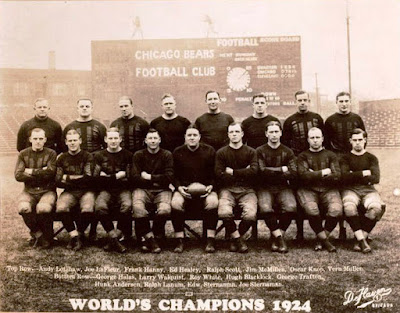 |
| Rockford High School sports pioneer Laurie Walquist is seated in the front row, second from left, next to George "Papa Bear" Halas. |
The Northern Illinois Conference's first great player remains its most accomplished - if you look at high school, college and professional accomplishments in total.
Laurie Walquist was a two-sport star at all three levels and one of the area's biggest winners. He was a halfback in the old single wing offense for the 1916 and 1917 Rockford Rabs. The Rabs were 7-3-1 in 1916 with Walquist scoring one touchdown and adding an extra point. He was the unquestioned star of the 1917 team, scoring five touchdowns and adding 12 extra points for a team that went 9-1 and finished with a claim as the top ranked team in the state.
Walquist and lineman Milton Olander went from starring at Rockford to the starting lineup of the University of Illinois in 1918. Both Walquist and Olander were starters all four years for the Illini.The 1918 team was Western Conference champions with a 5-0 record and the 1919 squad went 6-1 and has been picked retroactively as the national champion by the Billingsley Report and Boand System and co-national champion by the College Football Researchers Association.
Overall, in Walquist's four years in the starting backfield, the Illini went 20-8. Walquist had four passing touchdowns, three rushing touchdowns and a TD reception. Walquist was second team All-Big Western Conference in 1919 and first team all-conference in 1920 and 1921.
Walquist also played basketball at Illinois all four years. After finishing his final season, Walquist and fellow Rockford High School graduate Harry Englund signed with George Halas' Chicago Bears in the fledgling NFL.
Englund, who played with the Decatur Staleys in 1921, would play just that one year with the Bears. Walquist, though, would stick around until 1931, playing with many of the legends who got the pro game on solid footing.
Walquist's 1922 teammates included Halas, the player coach. In 1925, Walquist was in the backfield with Red Grange. In 1929, he was teammates with Paddy Driscoll. In 1931, he played with Bronko Nagurski.
While Walquist was never the big star, he was a star. He played in 111 games, starting 77. He had four touchdown passes, 10 rushing TDs and four receiving. More importantly, he was as big a winner in the pro ranks as he was in high school and college. The Bears had winning seasons in eight of his nine seasons - he didn't play in 1923. The 1926 Bears went 12-1-3. The 1922 and 1927 Bears were 9-3. Overall, Chicago was 73-36-16 with Walquist on the roster.
After the 1931 season, Walquist, who earned an economics degree at Illinois, transitioned to assistant coach and part-owner. He finally left the Bears in the mid-1930s to become sales manager at Chicago Furnace & Supply Co. He settled in Glenview and died in 1985.
| No. 1 - Laurie Walquist, Rockford | ||||
|---|---|---|---|---|
| Year | Level | Team | Accomplishments | Points |
| 1916 | High School | Rockford | Winning Team | 1 |
| 1917 | High School | Rockford | First Team All-Conference | 2 |
| Winning Record | 1 | |||
| Conference Champion | 1 | |||
| 1918 | College | Illinois | Letter Winner on Power 5 Team | 4 |
| Starter | 1 | |||
| Winning Team | 1 | |||
| 1919 | College | Illinois | Letter Winner on Power 5 Team | 4 |
| Starter | 1 | |||
| Second Team All-Western Conf. | 0.5 | |||
| Winning Team | 1 | |||
| National Champion | 1 | |||
| 1920 | College | Illinois | Letter Winner on Power 5 Team | 4 |
| Starter | 1 | |||
| Winning Team | 1 | |||
| First Team All-Western Conf. | 1 | |||
| 1921 | College | Illinois | Letter Winner on Power 5 Team | 4 |
| Starter | 1 | |||
| First Team All-Western Conf. | 1 | |||
| 1922 | NFL | Chicago | Played in NFL | 3 |
| Starter | 1 | |||
| Winning Record | 1 | |||
| NFL Runner Up | 1 | |||
| 1924 | NFL | Chicago | Played in NFL | 3 |
| Starter | 1 | |||
| Winning Team | 1 | |||
| NFL Runner Up | 1 | |||
| 1925 | NFL | Chicago | Played in NFL | 3 |
| Starter | 1 | |||
| Winning Record | 1 | |||
| 1926 | NFL | Chicago | Played in NFL | 3 |
| Starter | 1 | |||
| Winning Record | 1 | |||
| NFL Runner Up | 1 | |||
| 1927 | NFL | Chicago | Played in NFL | 3 |
| Starter | 1 | |||
| Winning Record | 1 | |||
| 1928 | NFL | Chicago | Played in NFL | 3 |
| Starter | 1 | |||
| Winning Record | 1 | |||
| 1929 | NFL | Chicago | Played in NFL | 3 |
| Starter | 1 | |||
| 1930 | NFL | Chicago | Played in NFL | 3 |
| Starter | 1 | |||
| Winning Record | 1 | |||
| 1931 | NFL | Chicago | Played in NFL | 3 |
| Starter | 1 | |||
| Winning Record | 1 | |||
| Totals | 77.5 | |||








